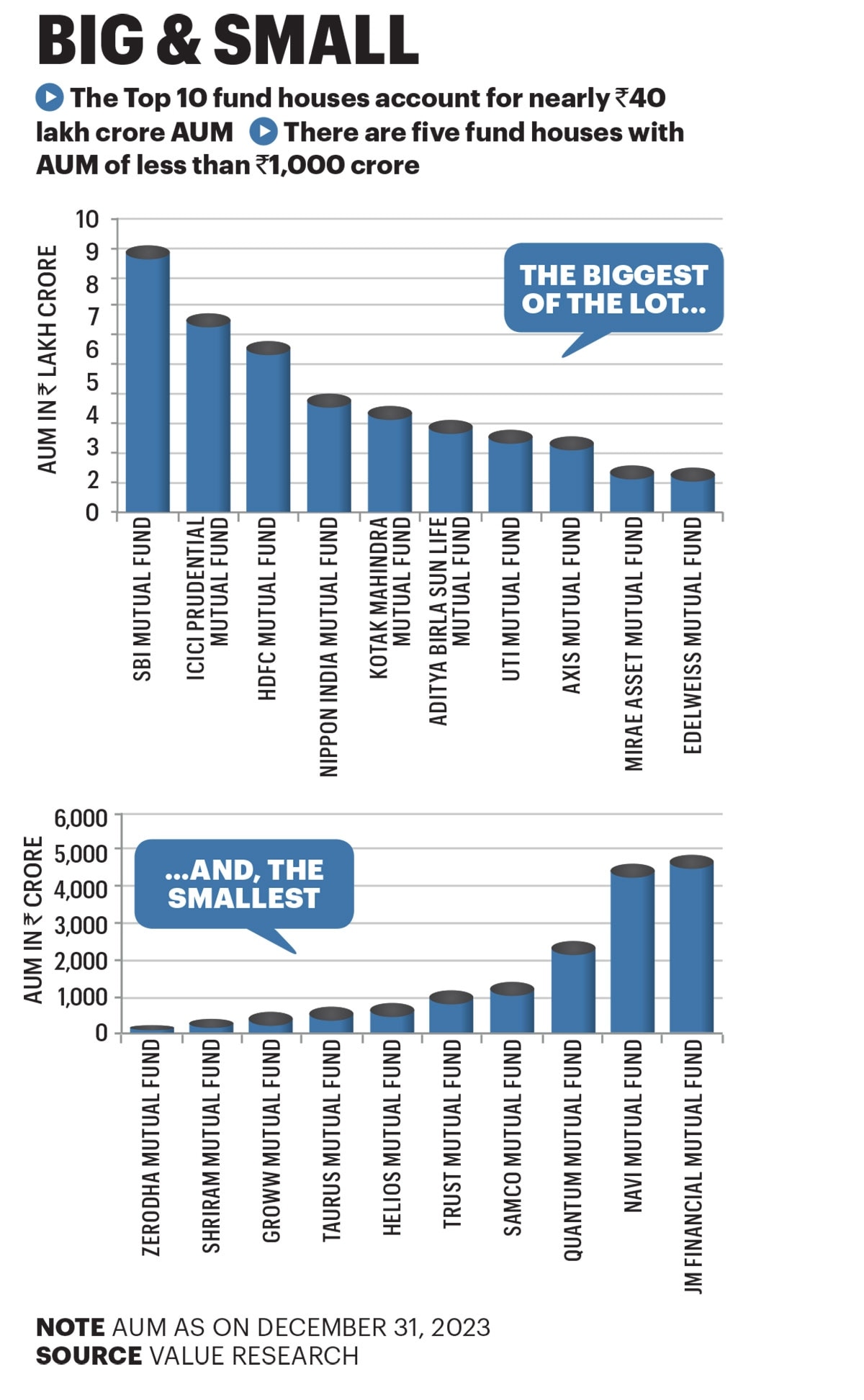
 The Indian mutual fund industry's assets have grown manifold in the past couple of years, attracting a clutch of aggressive new entrants. Will the dream run continue? And how will the players co-exist?
The Indian mutual fund industry's assets have grown manifold in the past couple of years, attracting a clutch of aggressive new entrants. Will the dream run continue? And how will the players co-exist?  The Indian mutual fund industry's assets have grown manifold in the past couple of years, attracting a clutch of aggressive new entrants. Will the dream run continue? And how will the players co-exist?
The Indian mutual fund industry's assets have grown manifold in the past couple of years, attracting a clutch of aggressive new entrants. Will the dream run continue? And how will the players co-exist? The Indian mutual fund industry definitely ended 2023 on a high. The industry’s total assets under management (AUM) breached the Rs 50-lakh crore mark for the first time.
This was no doubt a big milestone, but what cheered the industry even more was the time it had taken to reach this milestone. The industry’s AUM first crossed the Rs 10-lakh crore mark way back in May 2014. It doubled three years later, in August 2017. Three years later, in November 2020, it touched Rs 30 lakh crore. And then the gears shifted, and the next Rs 10 lakh crore was added in just two years, followed by the last Rs 10 lakh crore in a mere 13 months. Put another way, the mutual fund AUM swelled by Rs 40 lakh crore in a little under nine years.
Thanks to this spurt in growth, a large section of industry participants believe that the pace of growth will accelerate further and the industry’s AUM could more than double in four to five years.
What’s the reason for this optimism, one may wonder. It’s simple: The recent feats of the industry have been achieved with just a little over 40 million investors—a big jump from around 19 million in December 2018. Now, compare that with India’s population of 1.4 billion, and you can see why industry officials are bullish on the growth potential here.
It is this large opportunity that has attracted a slew of new players into this space, sparking a paradigm shift hitherto not seen until a couple of years ago. They include a number of new-age technology majors like discount broker Zerodha, PhonePe, Navi, Groww, and Samco. Besides, many older firms from the BFSI space are also making an entry here.
And there is perhaps no better evidence of the interest here than the recently announced joint venture between Jio Financial Services and BlackRock Financial Management Inc., which is awaiting regulatory approval.
Despite these big-bang entries into this space—where the capital markets regulator Securities and Exchange Board of India (Sebi) closely monitors every move of the fund manager and fund house—there are just 45 fund houses or asset management companies (AMCs). Of these, only 14 fund houses boast an AUM in excess of Rs 1 lakh crore each. This is why industry insiders see a lot of room for growth.
Although the space may seem to have become saturated for the casual observer, fund houses like to point out that the numbers are on a larger scale in developed countries. “The Indian mutual fund industry has around 40–45 fund houses, but if you look at the West, there are 200+ asset managers,” says Ruchi Pandey, CEO of Old Bridge Mutual Fund, which recently announced its maiden fund launch.
During the launch of the fund, Pandey said that such is the size of the overall savings pool that any new entrant just adds to the MF cause. Indeed, because mutual fund penetration is abysmal, to say the least, most fund houses are looking to both attract millions of new investors and, in turn, give a push to their own businesses and the industry’s overall AUM growth.
“The main objective we want to work towards is financial inclusion because we think that penetration level at this time is still limited with just 40 million unique PAN folios in a population of 1.4 billion,” says Vishal Jain, CEO of Zerodha Mutual Fund.
He says the question now is how to get the next 100 million investors to put their money into mutual fund products. “We are coming to the market with that focus. Our belief is that you can hit the number if you start looking at each of the small things and start solving that,” adds Jain, whose fund house has adopted a completely passive approach.
Passive funds seek to replicate the benchmark index, and there is no active buying or selling by a fund manager. Passive funds typically have a lower cost structure compared with active ones.
Another data point that industry players love to highlight is the total AUM as a percentage of the country’s gross domestic product, or GDP. At current levels, the number is pegged around 35%—which is significantly lower when compared to some of the other leading markets like the US, where it hovers around 100%. Incidentally, the Indian tally would be far lower if only the equity component was considered.
As of December 31, 2023, the total AUM of the MF industry was Rs 50.78 lakh crore, and the share of debt assets was Rs 12.91 lakh crore, per industry body Association of Mutual Funds in India (AMFI).
“If only equity AUM is considered, the AUM-to-GDP ratio will still be lower. In the US, the GDP to MF AUM is almost equal,” says A. Balasubramanian, MD & CEO of Aditya Birla Sun Life Mutual Fund, one of the largest fund houses in the country in terms of total assets.
He feels many more fund houses will enter the market and expand. “There is huge scope for more fund houses. If you go deeper into the country, people still prefer fixed deposits and local savings. That will change significantly,” says Balasubramanian.
In this backdrop, the tech-native new entrants are widely expected to onboard more investors thanks to their innovative approach to distribution. In the process, these firms have brought in massive innovation both in terms of product and distribution, launching schemes with various differentiated investment approaches.

With the influx of newcomers into the MF space, there has also been a rush to offer differentiated products. “We use technology to differentiate as well. In this investment driven industry with over 40 established players, any unique selling point must focus on investment strategies,” says Ganesh Mohan, CEO of Bajaj Finserv Mutual Fund.
“I would say for new AMCs particularly it is very important. When you do not have much of a track record in this business, and you are trying to build scale and relevance, having both differentiated products as well as the support of distribution is critical to be able to build the business,” he adds. As part of its own set of differentiators, Bajaj Finserv has come out with an investment philosophy based on InQuBe, the AMC’s proprietary framework that adds a layer of behavioural finance to the informational and quantitative edges.
“Distribution and customer service: That is the key for newer players. Innovation in distribution is required in terms of how to reach newer investors,” says Jain of Zerodha MF.
“One of the reasons why a lot of new players have come in is because of the coming of age of the digital ecosystem in India. That is what is triggering digital or online platforms across the fintech space. The digital ecosystem based on Aadhaar, or UPI, has helped onboard clients more easily today. I think the younger investors would possibly be the first to start using these platforms because they have grown in the digital age,” he adds. Incidentally, industry estimates suggest that there are 1.2 billion internet users in the country, 800 million e-commerce users, 500 million OTT subscribers, and 300 million UPI users.
But digital is not the only way ahead, and an omnichannel approach—a mix of digital and old-school touch points—may work best when dealing with a diverse and varied economy like India.
“When everyone says digital has come and physical will go, that is not true. You look at our customer pattern; digital is there, but we still go to brick-and-mortar shops. Yes, percentages change,” says Pandey of Old Bridge MF.
The share will definitely change, and the strategy that does the trick in a metro like Mumbai or Delhi may not be ideal for a Tier II or III town, but the market is clearly there, and with the right differentiation, new players can co-exist with older ones that have a track record, as the pie is too big.

There seems to be no doubt about the Indian MF industry’s huge potential for growth. The current penetration level or the number of investors is very low when compared to the number of e-commerce users or even those just using various food delivery apps—it is estimated to be around 280 million.
In fact, in a recent presentation, Bajaj Finserv MF highlighted that MF AUM surged by three to four times in countries like Malaysia and Thailand when their respective GDPs doubled in 10–15 years.
By FY30, the number of unique investors in MFs should get to around 100-120 million, and the AUM should be close to `130 lakh crore, says Mohan.
There seems to be unanimity amongst fund managers that the trick is to create a niche based on innovation in both product and distribution.
“New players will obviously take time to build a track record. Ultimately, the business will grow only for those who are deeply committed to growing it. If you look at the other markets as well, while there are only a few large players, there are many boutique firms as well. In the mutual fund business, your growth will be subject to your level of commitment,” says Balasubramanian.
The market is waiting. All that’s needed now is focus and commitment, getting the basics right, and sooner rather than later, the MF pie is bound to expand. In the pages that follow, we bring you various aspects of the mutual funds industry.
@ashishrukhaiyar
Copyright©2024 Living Media India Limited. For reprint rights: Syndications Today